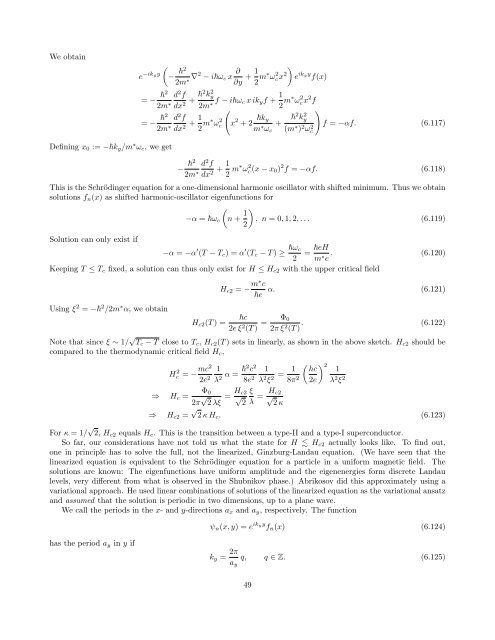Carsten Timm: Theory of superconductivity
Carsten Timm: Theory of superconductivity
Carsten Timm: Theory of superconductivity
You also want an ePaper? Increase the reach of your titles
YUMPU automatically turns print PDFs into web optimized ePapers that Google loves.
We obtain<br />
e −ik yy<br />
(− 2<br />
2m ∗ ∇2 − iω c x ∂ ∂y + 1 )<br />
2 m∗ ωc 2 x 2 e ikyy f(x)<br />
= − 2 d 2 f<br />
2m ∗ dx 2 + 2 ky<br />
2<br />
2m ∗ f − iω c x ik y f + 1 2 m∗ ωc 2 x 2 f<br />
= − 2<br />
2m ∗ d 2 f<br />
dx 2 + 1 2 m∗ ω 2 c<br />
(<br />
x 2 + 2 k y<br />
m ∗ ω c<br />
+<br />
2 k 2 y<br />
(m ∗ ) 2 ω 2 c<br />
)<br />
f = −αf. (6.117)<br />
Defining x 0 := −k y /m ∗ ω c , we get<br />
− 2<br />
2m ∗ d 2 f<br />
dx 2 + 1 2 m∗ ω 2 c (x − x 0 ) 2 f = −αf. (6.118)<br />
This is the Schrödinger equation for a one-dimensional harmonic oscillator with shifted minimum. Thus we obtain<br />
solutions f n (x) as shifted harmonic-oscillator eigenfunctions for<br />
(<br />
−α = ω c n + 1 )<br />
, n = 0, 1, 2, . . . (6.119)<br />
2<br />
Solution can only exist if<br />
−α = −α ′ (T − T c ) = α ′ (T c − T ) ≥ ω c<br />
2 = eH<br />
m ∗ c . (6.120)<br />
Keeping T ≤ T c fixed, a solution can thus only exist for H ≤ H c2 with the upper critical field<br />
Using ξ 2 = − 2 /2m ∗ α, we obtain<br />
H c2 (T ) =<br />
H c2 = − m∗ c<br />
e<br />
α. (6.121)<br />
c<br />
2e ξ 2 (T ) = Φ 0<br />
2π ξ 2 (T ) . (6.122)<br />
Note that since ξ ∼ 1/ √ T c − T close to T c , H c2 (T ) sets in linearly, as shown in the above sketch. H c2 should be<br />
compared to the thermodynamic critical field H c ,<br />
Hc 2 = − mc2 1<br />
2e 2 λ 2 α = 2 c 2 1<br />
8e 2 λ 2 ξ 2 = 1 ( ) 2 hc 1<br />
8π 2 2e λ 2 ξ 2<br />
Φ 0<br />
⇒ H c =<br />
2π √ 2 λξ = H c2 ξ<br />
√<br />
2 λ = H c2<br />
√<br />
2 κ<br />
⇒ H c2 = √ 2 κ H c . (6.123)<br />
For κ = 1/ √ 2, H c2 equals H c . This is the transition between a type-II and a type-I superconductor.<br />
So far, our considerations have not told us what the state for H H c2 actually looks like. To find out,<br />
one in principle has to solve the full, not the linearized, Ginzburg-Landau equation. (We have seen that the<br />
linearized equation is equivalent to the Schrödinger equation for a particle in a uniform magnetic field. The<br />
solutions are known: The eigenfunctions have uniform amplitude and the eigenenergies form discrete Landau<br />
levels, very different from what is observed in the Shubnikov phase.) Abrikosov did this approximately using a<br />
variational approach. He used linear combinations <strong>of</strong> solutions <strong>of</strong> the linearized equation as the variational ansatz<br />
and assumed that the solution is periodic in two dimensions, up to a plane wave.<br />
We call the periods in the x- and y-directions a x and a y , respectively. The function<br />
ψ n (x, y) = e ikyy f n (x) (6.124)<br />
has the period a y in y if<br />
k y = 2π<br />
a y<br />
q, q ∈ Z. (6.125)<br />
49

















